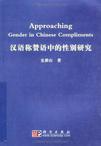汉语称赞语中的性别研究
2008-1
科学出版社
史耕山
307
无
为了更好揭示语言与性别之间的互动关系,本文运用民族学的方法对发生在三个汉语言语社区的939个称赞语进行了实地考察和定性、定量分析。我们首先考察了称赞语在不同性别组和角色关系上的总体分布情况,然后将相关情景因素保持一致,深入作了一些情景对比,旨在进一步突出性别在日常交际中的作用。 通过对比分析(性别在称赞频率、策略、话题、回应、功能、效果和褒义语义载体等层面的分布),我们提出性别与宏观社会文化语境以及微观情景语境互动的理论模式。因此,性别差异是动态的、相对的,并受这两个语境的制约。同时,我们认为女性与男性的话语风格虽有差异,但也有相似之处。在本次研究中,我们发现至少有四种条件会使性别话语交际发生趋同现象。最后我们还探讨了性别互动的社会语用功能。 本次研究在理论、实践和方法论三个方面有以下意义: 首先我们发现性别话语风格在言语交际中受到宏观社会文化规约以及微观情景因素的共同影响。因此,只有将社会因素与情景因素结合起来,我们才能更好地考察语言与性别之间的共变。另外,我们还对本土语料展开了实地调查。这为语言与性别研究提供了第一手的、更有说服力的调查依据。 其次,本次研究将有助于我们更好理解不同性别身份在日常交际中的运作机制,有助于我们对性别身份申的差异性和趋同性有一个更加明晰的认识。性别交际是能动的、有创造性的,其目的是为了使交流更顺利、更有成效。 最后,我们在研究方法论的革新方面也进行了有益的尝试。在本次研究申,我们选择了三个基本同质的言语社区作为研究对象。这样可以把调查结果在三个社区之间进行对比,从而使自己的研究结论更具有说服力和代表性。另外,我们还进行了问卷调查和访谈。总之,不同的方法之间扬长避短,形成互补,从而提高了研究效果。
1972年10月出生,北京师范大学外文学院文学博士,北京外国语大学出站博士后,河北工业大学外国语学院院长。主要从事社会语言学和外语教学领域的研究,近年来文章见于《外语与外语教学》、《外语教学》、《外语研究》、《四川外语学院学报》、《河北师范大学学报》等核心期刊,学术专著有《汉语称赞语中的性别研究》(2008年1月,科学出版社),完成“河北省社科基金”等省部级或厅级项目6项。
序Acknowledgements摘要AbstractList of AbbreviationsChapter One Introduction1.1 Rationale1.2 Working definitions of gender and compliment1.2.1 Gender1.2.2 Complinent1.3 Scope of the research1.4 Organization of the dissertationChapter Two Literature Review and Criticism2.1 Literature review of research on compliments2.1.1 Literature review of research on compliments abroad2.1.2 Literature in Chinese2.1.3 Summary2.2 Literature review of language and gender research2.2.1 Literature review of language and gender research abroad2.2.1.1 The folk linguistic stage2.2.1.2 The anthropological stage2.2.1.3 The early sociolinguistic stage2.2.1.4 Gender differences in language use2.2.2 Literature review of language and gender research at home2.2.3 SummaryChapter Three Research Description3.1 The general analytical framework for language and gender3.1.1 Covariation between gender and socio-cultural context3.1.2 Covariation between gender and situational context3.1.3 Summary3.2 The concrete situational approach to gender in Chinese compliments3.2.1 Gender group3.2.2 Setting3.2.3 Participants3.3 Research questions3.4 Research methodology3.5 Research procedure3.6 Data codification3.6.1 The coding scheme for analyzing compliment strategies3.6.2 The coding scheme for analyzing compliment responses3.6.3 The coding scheme for analyzing compliment topics3.6.4 The coding scheme for analyzing compliment functions3.6.5 The coding scheme for analyzing compliment effects3.6.6 The coding scheme for analyzing semantic carrirs and turns-takingChapter Four Investigating Compliments on the Campus4.1 Compliment distribution on gender groups and participant relationships4.1.1 Compliment distribution on gender groups4.1.2 Compliment distribution on participant relationships4.1.3 The distribution of gender groups on participant relationships4.1.4 The distribution of participant relationships on gender groups4.1.5 The distribution of compliment topics4.1.6 The distribution of compliment strategies4.1.7 The distribution of compliment responses4.1.8 The distribution of compliment functions4.1.9 The distribution of compliment effects……Chapter Five Investigating Compliments in the VillageChapter Six Investigating Compliments in the Working-class CommunityChapter Seven Gender Differences: Illustrations and InterpretationsChapter Eight Gender Similarities: Illustrations and InterpretationsChapter Nine Gender Interaction: Its Sociopragmatic FunctionsChapter Ten ConclusionReferencesAppendices中文题要

无